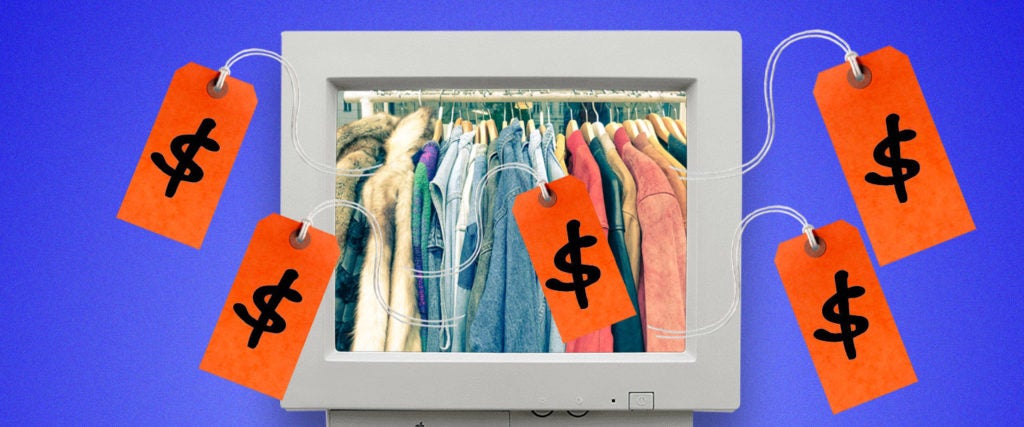If you’re like me, your favorite clothes — the pieces you’re most proud of or the ones you feel most define your personal aesthetic — come from a vintage store. Sometimes the jackets are missing buttons or the T-shirts smell a bit like your grandfather’s closet, but that funk is part of their character. In a world where nearly every item of clothing is mass-produced to the point of oblivion, a pair of slacks from the 1970s or a leather jacket from the 1950s is one of the few outlets that bestows a sense of exclusivity amidst the ASOS of it all.
But if you’re familiar with the joys of excavating a rack full of vintage clothes as you search for that one T-shirt that’s soon to be your favorite, you know that these days, shopping for vintage isn’t what it used to be: We’re still in the clutches of a pandemic and hopefully you’re trying to curb your unnecessary outings — not to mention you can’t even try on the clothes in the store anymore.
Still, you miss it. You miss the search. You miss the satisfaction of finding something that’s so perfect it feels like it was designed just for you. And the good news is that just because you’re mostly relegated to online shopping, that doesn’t mean you can’t shop vintage. In fact, says Ian Campbell of online vintage store Arbitrage NYC, vintage shopping is having a real renaissance right now, adding that you can find amazing vintage dealers on Instagram as well as on major resale sites like Etsy and Grailed. “I’d always recommend developing a relationship with dealers you love,” he says. “Memorable customers often get the best deals and the right of first refusal, and dealers will keep you in mind when they’re on the hunt for a new product.”
Of course, the issue with all online shopping, but especially vintage shopping, is figuring out the quality or feel of an item of clothing. To that point, Campbell suggests considering where the item was made. “These days, global production has come a long way and you can find well-made clothing made most anywhere, but the older an item of clothing is, the better it is to stick to North America and Europe,” he says. “And though there are exceptions to every rule, in general, you’ll find sturdier materials and better fits from American and European vintage.”
As for judging the condition of an item that you can only see pictures of, Campbell admits that it really comes down to your taste. “Some prefer to find deadstock, unworn clothing, and others love the well-worn and lovingly repaired pieces,” he says. “Personally, I fall into the latter camp.” But he also tells me that the thing to look out for is signs of moth bites and holes/snags in knitwear, “Both of which are more trouble than they’re worth.”
Another way to judge the quality of a piece of vintage clothing, according to Casey Kohn, of online vintage store Coupe De Grâce, is by judging how it’s aged. “Has it held up in the tension point areas?” Kohn asks. “Does it have organic fading? Anything well-made ages with grace. That’s the secret to judging if a product is quality.”
Even then, though, just because a piece of vintage clothing is well made, it doesn’t mean it’s going to fit you well, which is why Campbell says that, while it’s best to have every measurement before purchasing online, the most important is the shoulders. “If the item fits your shoulders, then it will look great more often than not,” he says. “Beyond that, it’s helpful to have a good understanding of what it costs for a tailor to make certain adjustments. Hemming a pant or bringing in the waist is relatively cheap, but if you want something tapered, or a surgeon’s cuff brought up, it’ll be pricey.”
Hemming aside, Kohn tells me that for pants, it’s always important to check or ask for the length of the inseam. “Often people tailor the length of pants without mentioning it, and if you don’t check there, you can end up with some short pants,” he says.
Another secret of the vintage-shopping trade, per Kohn, is to use the online data as a way to judge whether or not you’re getting a good price. “Look up sold listings — not just for sale listings — so that you can accurately appraise your items and figure out if an item is worth buying.”
Most importantly though, don’t wait too long before making a decision. “If a piece of vintage speaks to you, jump on it!” Campbell advises. “The great thing about vintage is the uniqueness of every piece, so don’t talk yourself out of something you really love, as you’ll probably not see another like it.”
As someone who has overslept on several pieces of vintage in the past and watched as they were grabbed away from my virtual shopping bag, I couldn’t agree more.

